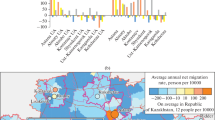Abstract
A policy of urban decentralisation, limiting or discouraging the growth of population, has been commonly adopted for spatial planning in developing countries over the past decades. Delhi is in a transition stage and sprawling over the years to nearby periphery towns, but NCT Delhi’s urban influence decreases with the increasing distance from the core. Delhi’s urbanization process highly influences the towns within a radius of 50 km from the core. Some Towns located beyond 100 km of radius are also experiencing high growth of urban population because they are the nodal points surrounding the rural hinterland. The later decades of urban development in NCR Delhi led to a high rate of population growth because of the improved employment growth and other economic opportunities that came as a result of inflow of capital and investment to the region. On the other hand, decentralization of employment, urban growth, coupled with the services and housing supply promotes the growth of main and small urban centres in the periphery which is further boosted by a good transport network, connecting and integrating the National Capital Region. Delhi is experiencing declining growth of population and on the other hand, periphery towns are getting boosted by the urban growth.

Source: National Capital regional Plan, 2021


Similar content being viewed by others
References
Bayoh, I., Irwin, E. G., & Haab, T. (2002). Flight from blight vs. natural evolution: Determinants of household residential location choice and suburbanization. In 2002 Annual meeting, July 28–31, Long Beach, CA (No. 19668). American Agricultural Economics Association (New Name 2008: Agricultural and Applied Economics Association).
Becker, C. M., Williamson, J. G., & Mills, E. S. (1994). Indian urbanisation and economic growth since 1960. Economic Development and Cultural Change, 42(2), 456–462.
Bentick, I. (2000). Unruly urbanization of the Delhi ‘s fringe. Changing patterns of land use and livelihood, Rijksuniversiteit Groningen (Vol. 270, p. 190). Groningen: Netherlands Geographical Studies.
Berg, L. V. D., Drewett, R., Klaassen, L. H., Rossi, A., & Vijverberg, C. H. T. (1982). Urban Europe: A study of growth and decline (Vol. 1, p. 175). Oxford: Pergamon Press.
Champion, T. (2001). Urbanization, suburbanization, counterurbanization and reurbanization. In R. Paddison & W. Lever (Eds.), Handbook of urban studies. London: Sage.
District-wise Primary census abstract (PCA), Census of India, 1991, 2001 and 2011. http://censusindia.gov.in/.
Dupont, V. (2004). Urban development and population redistribution in Delhi: Implications for categorizing population. In T. Champion & G. Hugo (Eds.), New forms of urbanization: Beyond the urban-rural dichotomy (pp. 171–190). Aldershot: Ashgate.
Haque, I., Das, D. N., & Patel, P. P. (2018). Spatial segregation in Indian cities: Does the city size matter? Environment and Urbanization Asia, 9(1), 52–68.
Jain, M., & Dimri, A. P. (2016). Urban sprawl patterns and processes in Delhi from 1977 to 2014 based on remote sensing and spatial metrics approaches. Earth Interactions, 20, 1–28.
Jain, M., & Siedentop, S. (2014). Is spatial decentralization in National Capital Region Delhi, India effective? An intervention-based evaluation. Habitat International, 42, 30–38.
Jain, M., Siedentop, S., Taubenböck, H., & Sridharan, N. (2013). Suburbanisation to counterurbanisation? Investigating dynamics of urban development in National Capital Region Delhi. Environment and Urbanisation in Asia, 4(2), 247–266.
Jain, M., Taubenböck, H. & Namp, S. (2011). Seamless urbanisation and knotted city growth: Delhi Metropolitan Region, In REAL CORP 16th international conference on change for stability: Lifecycles of cities and regions, Essen.
Klassen, L. H., Molle, W. T. M., & Paelinck, J. H. P. (Eds.). (1981). Dynamics of urban development. Aldershot: Gower.
Kundu, A., & Lopamudra, R. S. (2012). Migration and exclusionary urbanisation in India. Economic & Political Weekly, 47(26/27), 219–227.
Kundu, A. Shariff, A. & Ghosh, P. K. (2002). Indexing human development in India: Indicators, scaling and composition, working paper series No.83, National Council of Applied Economic Research, New Delhi, India.
Lim, G. C. (2005). Globalization, spatial allocation of resources and spatial impacts: A conceptual framework. In H. W. Richardson & C. H. C. Bae (Eds.), Globalization and urban development, pp. 13–28.
Mahadevia, D. (2001). Sustainable urban development in India: An inclusive perspective. Development in Practice, 11(2/3), 242–259.
Mieszkowski, P., & Mills, E. S. (1993). The causes of metropolitan suburbanization. Journal of Economic Perspectives, 7, 135–147.
Mohan, M., & Payra, S. (2009). Influence of aerosol spectrum and air pollutants on fog formation in urban environment of megacity Delhi. India, Environmental monitoring and assessment, 151, 265–277.
Mookherjee, D. (2004). Cities in transition: Monitoring growth trends in Delhi urban agglomeration 1991–2001. Dela, 21, 195–203.
Sahasranaman, A. (2012). Financing the development of small and medium cities. Economic & Political Weekly, 47(24), 59–66.
Shama, P. (2004). Population growth and sustainable development. Economic and Political Weekly, 29(7), 629–633.
Shaw, A. (2005). Peri-urban interface of Indian cities: Growth, governance and local initiatives. Economic and Political Weekly, 40(2), 129–136.
Vyas, S. & Kumaranayake, L. (2006). Constructing socio-economic status indices: How to use principal components analysis Health Policy and Planning Nov 1, 2006, PMID: 17030551 https://doi.org/10.1093/heapol/czl029.
Author information
Authors and Affiliations
Corresponding author
Ethics declarations
Conflict of interest
There is no conflict of interest and authors takes full responsibility of the article.
Additional information
Publisher's Note
Springer Nature remains neutral with regard to jurisdictional claims in published maps and institutional affiliations.
Rights and permissions
About this article
Cite this article
Morya, C.P., Ram, M. Dynamics of suburbanization and influence of National Capital Territory of Delhi on towns. GeoJournal 85, 1725–1743 (2020). https://doi.org/10.1007/s10708-019-10052-y
Published:
Issue Date:
DOI: https://doi.org/10.1007/s10708-019-10052-y




